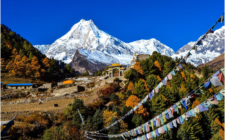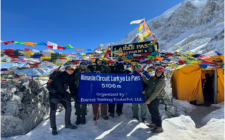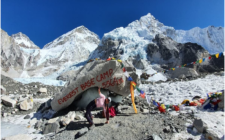The Everest Three High Passes Trek is a treacherous journey through some of the world’s most rugged and remote terrain. This trek requires preparation, resilience, and expert guidance with its challenging terrain, high-altitude passes, and ever-changing weather conditions. An experienced Sherpa expedition team is the answer to this challenging question.
It is highly recommended to have a Sherpa guide if undertaking the Everest Three High Passes Trek. Sherpas are known for their deep connection to the mountains, durability, and intimate knowledge of the region’s terrain. Their skills are not just important in terms of navigating the rocky trails, but to tackle the physical side of the trek, especially at the altitude. Having spent years and years in the Himalayas, Sherpas make sure that trekkers follow the safest paths and maintain a steady pace, which is key to proper acclimatization, and in turn important to avoid altitude sickness.
The trek takes you over three major high passes — Kongma La, Cho La, and Renjo La — all of which offer a unique challenge. Dealing with snow, ice, and rocky terrain, the weather can make crossing these passes challenging as well. But with the help of Sherpa experts, trekkers can be confident in the knowledge that they are safely traversing these challenging patches of terrain. In addition to guiding, Sherpas play a key role in managing acclimatization, allowing trekkers to have adequate rest days, hydrate, and eat enough to lower the risk of altitude sickness.
In addition to their guiding abilities, Sherpas provide an introduction to the local culture that makes trekking even more special. As trekkers pass through Sherpa villages, meeting locals introduces them to the rich culture, religion, and way of life, which adds to the connection with the region they are just traveling through. It is thanks to the Sherpa team — with their balance of professionalism warmth, and knowledge — that this trek is not just an adventure, but an expedition of discovery and growth, physically and culturally.
Everest Three High Passes Trek Overview
The Everest Base Camp Three Pass Trek is an epic and challenging hike through the rugged terrain of Nepal’s Khumbu region, providing trekkers with a thrilling experience and stunning vistas. This trek consists of three high-altitude passes, Kongma La, Cho La, and Renjo La, which all rise above 5,000 meters (16,400 feet), making it one of the most difficult trekking routes in the world. The Three High Passes Trek is a far less traveled trekking route than the Everest Base Camp Trek and will take you through quieter, yet equally stunning landscapes in the Himalayas! Along the route, trekkers are treated to sweeping views of the world’s tallest peaks, including Mount Everest, Lhotse, Makalu, and Cho Oyu. Trekking Everest Base Camp not only offers breathtaking views of the world’s highest peak but also a glimpse into the rich Sherpa culture. Trekkers pass through traditional villages, visit ancient monasteries, and experience the local way of life. This challenging trek takes 18 to 21 days and requires good levels of fitness and mental fortitude, whilst crossing jagged terrain, steep ascents, and spirally-thin air. But this trek stands out as a true experience of a lifetime for hardy travelers willing to brave the ups and downs, both literally and figuratively, because of the incredible feeling of achievement and the breathtaking sights the Himalayas have to offer.
How to Choose the Right Sherpa Expedition Team
Selecting the Sherpa expedition team to do the Everest Three High Passes Trek is very important for the success and safety of the adventure. Not only are their guides experts, but they are also climbers who have vast knowledge of the terrain including the weather and the cultural aspects around Everest as well. They form the backbone of any trekking party in the Himalayas, and an experienced team can play a crucial role in ensuring a seamless and safe adventure. In choosing a Sherpa team, it is vital to ensure the organization has experienced and certified guides with proven records in high-altitude trekking. A good team should also make safety and acclimatization a priority, ensuring you have qualified assistance should you develop any altitude sickness-related health issues. The best Sherpa guides know emergency protocols and are trained in first aid. Not only is safety ensured, but an experienced Sherpa team will also enhance your trek with insights about the local culture, stories from the region, and guidance through the remote, rugged terrain. In addition, local Sherpas play an essential role in following the high passes, erecting tents, and transportation during the entire trek. When selecting a Sherpa team, use the following checklist to gauge their reputation, reviews from past trekkers, and the degree of personalized service they provide. A reliable team will ensure you make the most of the adventure while prioritizing your safety and well-being.
How to Plan and Prepare for the Trek
Title: Preparation for the Everest Three High Passes Trek. This is a tough trek that requires high altitudes. Proper preparations are essential. Begin with an assessment of your fitness level. The trek demands cardiovascular endurance, leg strength, and stamina, so commit to a regular training program that includes long-distance hikes, running, and strength training focusing on the legs and core. Acclimatization is a major part of preparation — for several weeks before the trek, hike at altitude to help your body get used to thinner air. Mental preparation is also key, as the trek can be physically strenuous with long, tiring days and variable weather conditions. Gear preparation is just as crucial: be sure to bring high-quality hiking boots, warm layers for cold temperatures, a lightweight backpack, trekking poles, and a sleeping bag that can handle high-altitude environments. You will also need certain items, such as a headlamp, sunscreen, and a first-aid kit. Choosing when to do the trek is important — spring and autumn are the ideal seasons for clear weather and stable conditions. Finally, make sure to get the necessary trekking permits, namely the Sagarmatha National Park permit and the TIMS card. You should have a discussion with a professional guide or a trekking company to finalize your logistics and follow health and safety protocols — especially regarding altitude sickness.
Three High Passes Overview
Everest Base Camp Three Pass Trek itinerary Kongma La, Cho La, and Renjo La are three high-alpine passes to pass on the Everest Three High Passes Trek. All of these passes are unique challenges, allowing trekkers an experience in the Everest region that is truly one of a kind, away from much of the congestion common routes, such as the Everest Base Camp Trek, can run into. Kongma La at 5,535 meters (18,159 feet) is the first pass and provides a tough climb. The views from the pass are magnificent, with Mount Everest, Lhotse, and Makalu all visible. The second one, Cho La (5,420 meters or 17,782 feet), is also icy and narrow, making it one of the harder passes to cross. The Cho La Pass offers stunning views of the Khumbu Glacier and nearby mountain peaks. The final pass, Renjo La (5,360 meters, or 17,585 feet), is the least crowded and most serene of the three. From Renjo La, trekkers enjoy some of the most stunning views of Everest and Lhotse, and panoramic views of the surrounding peaks. Crossing these passes is not just physically challenging, but the reward is extraordinary, particularly stunning views of the Himalayas and a strong sense of achievement on completing the strenuous crossing.
Trekking Highlights: Major Landmarks
Extensive in duration, Everest Three High Passes Trekking usually lasts from 18 to 21 days depending upon the acclimatization, exploration, and rest. The first few days of the trek are spent hiking from Lukla to Namche Bazaar, the Sherpa capital, where trekkers can acclimatize themselves to the altitude and discover the bustling local culture. From Namche, trekkers head up on a steady incline, through charming villages such as Tengboche, Dingboche, and Lobuche. Trekking at Dingboche, trekkers have a rest day to adjust before attempting the passes. On Day 9, the journey starts with the climb to Kongma La (5,535 meters/18,159 feet), the highest and most challenging of the three passes. After obtaining Kongma La, trekkers descend to the valley below and head in the direction of the second pass, Cho La (5,420 meters/17,782 feet), on Day 11. The icy conditions of Cho La and the steep climb may start deterring you, but just look around you at the peaks surrounding you, the efforts are definitely worth it. On Day 14, hikers make their way over the last pass, Renjo La (5,360 meters/17,585 feet), for a quiet setting and sweeping views of Everest. After crossing the passes, the trekkers descend, retracing their steps back through Namche Bazaar and Lukla, where the trip ends. Rest days are highlighted along the trek to ensure adequate acclimatization and trekkers are advised to hike at their own pace in order to avoid altitude sickness.
How to adapt to the high altitude environment
The Everest Base Camp Three Pass Trek cost is not easy because it involves high altitudes above 5,000 meters (16,400 feet). Trekking at high altitudes is difficult and changes with elevation increase the risk of altitude sickness, which can be fatal if its symptoms are not handled accurately. One of the most important methods of acclimatization is to practice the climb high, sleep low principle. This entails hiking to higher altitudes during the day but then descending to lower altitudes at night so as to give the body time to acclimatize. With strategically placed rest days in remote mountain villages like Namche Bazaar and Dingboche, the trek allows for gradual acclimatization. Hydration, nutrition, and not pushing too hard are critical during these rest days. Many climbers supplement with oxygen or Diamox, a drug used to promote acclimatization, but either of these should only be undertaken with medical advice. It’s important to watch for symptoms of altitude sickness, like headaches, dizziness, and nausea, and to descend immediately if they worsen. One other tip that helps is keeping up a slow, steady pace to prevent overexertion and to give the body a chance to adjust to the thinning air. So, now the thing is, be emotionally prepared, because yes, the Everest Three High Passes trek is really tough, so go slow, keep yourself hydrated, and take a day to rest every 3 days, if necessary.
Essential Gear for the Trek
Having the appropriate gear is vital for safety and comfort, and the Everest Three High Passes Trek requires proper planning. The high-altitude terrain and variable weather conditions demand smart packing. One of the essentials is a pair of waterproof, sturdy hiking boots with strong ankle support for navigating rocky trails and steep climbs. The clothing layers you pack must be moisture-wicking — thermal base layers, high-quality down jackets — to ensure you stay dry, because temperatures can drop, especially overnight.
You will need a solid backpack to hold critical items in between water, snacks, and personal belongings, but it needs to be light enough for comfort on long days trekking. Trekking poles are another crucial component, providing stability on uneven terrain, particularly when traversing high passes such as Kongma La, Cho La, and Renjo La. Aside from that, sunglasses with UV protection and sunscreen are essential for protection from the sun and glare from the snow.
A decent sleeping bag rated for sub-zero temperatures will keep you warm during overnight stays in basic teahouses or camps. Essential gear also includes a headlamp, spare batteries, a first aid kit and a camera to take pictures of the views. Hydration systems (water bottles or Camelbaks): Dehydration is a real risk of high-altitude trekking, so hydration systems are a must. Packing the right gear can make for a safer and more enjoyable trekking experience in the treacherous Everest region.
How To Overcome Struggles On The Trail
The Everest Three High Passes Trek is a strenuous and tough expedition and requires proper preparation and determination. The first challenge is the higher altitude. As climbers make their way to altitudes that exceed 5,000 meters, the body must acclimate to lower concentrations of oxygen, which can lead to altitude illness or AMS. This is the reason the acclimatization is critical. The trek is designed to include built-in rest days to help trekkers acclimatize, but it’s essential to remain aware of your health for any signs of altitude sickness — headaches, dizziness, nausea, among others. It’s also key to listen to your body and take breaks if needed.
Everest Base Camp Three Pass Trek price Another big challenge is the terrain. The trail features steep climbs and drops, rocky paths, and areas that might be icy or snow-covered. Trekking poles are a true asset when it comes to keeping your balance on these uneven surfaces. Getting your pacing right and finding your rhythm is crucial to success — the distance will wear you down long before the terrain.
Cold temperatures and potential snowstorms contribute to fickle weather, and trekkers must be prepared for fast-changing conditions. Wearing layers, including outerwear that is waterproof and windproof, is key to staying warm and dry. With the guidance of Sherpa guides, familiar with the region’s weather patterns and terrain, trekkers are better suited to navigate these challenges and keep safe on the journey.
The Team at Each Stage of the Way
Sherpa guides bring with them unparalleled knowledge and support when hiking the Everest Three High Passes. Sherpas, an ethnic group that lives in the Everest region, are known for their skills in trekking and climbing at low temperatures. Trekkers rely on their good knowledge of the terrain and prevailing weather conditions, among other factors. Sir Hillary, Edmund Hillary, and a few early explorers relied on Sherpas not just as guides, but as experienced mountaineers who understood the unique requirements of high-altitude trekking (which means trekking up to the mountains).
Sherpas play a vital supportive role in acclimatization. They understand exactly how fast to go to prevent trekkers from climbing too high too quickly, which can result in altitude sickness. Sherpas also teaches you about pacing yourself physically and how to refuel and hydrate as you walk. Their experience allows them to make important decisions on the fly, guaranteeing that trekkers choose the safest path and steer clear of potential hazards such as avalanches or severe weather.
Everest Base Camp Three Pass Trek map Ultimately, Sherpas are not only technical climbers, they are also holders of cultural knowledge. They tell stories about the region’s history, Buddhist traditions, and their own way of life, giving trekkers a richer, more immersive experience. Their presence brings safety and companionship, and many trekkers become close with their Sherpa guides. Not just physically successful, but culturally enriching — those are the kinds of experiences you can expect to have with Sherpas because they have incredible experience and are great people.
Cultural Immersion: Learning about the Lifestyle of the Sherpas
Everest Three High Pass Trek offers trekkers a unique chance to experience the Sherpa way of life. The Khumbu region is home to the Sherpa people, who have lived in the shadow of Mount Everest for centuries. They have an expansive soul because they live in the high-altitude mountain peaks. Their spirits are rooted in the mountains, as are their customs, language, way of life, and everything else. Trekkers who pass through Sherpa villages are frequently welcomed into homes and teahouses to learn directly about the rich cultural heritage of the area.
Tibetan Buddhism is at the core of Sherpa traditions and affects many facets of daily life. The area is home to Buddhist monasteries, stupas, and prayer flags, symbols of the Sherpas’ faith. Trekking through these villages allows trekkers to witness religious practices on a small scale, like monks chanting in the monasteries and locals making offerings at sacred sites. This window into the spiritual side of Sherpa culture is, for many trekkers, a highlight of the journey.
Sherpas are renowned for being hardy and friendly. Their warmth and generosity help to make trekkers feel welcome, whether over a cup of butter tea or tales of expeditions gone by. While trekking alongside the Sherpas, trekkers learn about the community’s traditions and values as well as the profound respect they hold for nature. Trekking through these villages, we forge a deep connection to the Everest region, transforming our traverse from a mere physical challenge to a deeply meaningful cultural expedition.
You will also be trained in Safety Protocols and Emergency Procedures.
While trekking through the remoteness and ruggedness of the Everest landscape, Everest Three High Passes remains one of the toughest routes for safety. With the high-altitude conditions, challenging terrain, and unpredictable weather, it’s critical to follow strict safety protocols and prepare for emergencies.
Acclimatization is one of the most critical components of safety. Correct adaptation to altitude is of great importance to avoid altitude sickness, and sherpa guides are well-trained to manage acclimatization plans. There are built-in rest days in the itinerary, so trekkers have time to acclimatize themselves to the higher altitudes before forging ahead. Going slow and steady minimizes the risk of altitude-related illnesses, and guides are constantly looking for indications of distress.
Trekkers also need to be prepared for evacuation in case of emergencies like severe altitude sickness or injury. Insurance, including helicopter evacuation, is offered by many trekking agencies, and it may be the key to getting trekkers to safety in a hurry. Guides carry satellite phones or radios to stay in touch with base camps or emergency services. Sherpas are also trained in first aid and can treat minor injuries or medical problems on the trail.
Everest Base Camp Three Pass Trek package A well-equipped first aid kit, the right attire for different weather conditions, and effective communication with the expedition team elevate safety during the trekking trail. With strict adherence to safety measures and the aid of experienced tour guides, trekkers finally can confidently trek at Everest Three High Passes, assured of being prepared for whatever emergency may arise.
The Completion: Celebrating The Achievement.
Trek to Everest Three High Passes is an incredible feat that results in immense personal satisfaction for the trekkers. The hike is one of the toughest high-elevation pathways in the world, demanding physical endurance as well as mental grit and meticulous planning. As trekkers cross the high passes of Kongma La, Cho La, and Renjo La and summit the pinnacle of their adventure, nothing compares to the feeling of success. It is ecstasy — the majestic Himalayan views of the Everest, Lhotse, and other towering peaks that surround you on every side and the satisfaction of overcoming the highest terrain on the planet.
The achievement is often celebrated with a sense of awe as trekkers recall the journey that has led them there. Indeed the altitude sickness, the inhospitable terrain, and the unpredictable weather make this hike determination-summing, but also the completion of it rewarding. The fun together with other trekkers and the support of the Sherpa guide make this experience one of success and cohesion.
After conquering a physical challenge and immersing themselves in the forefront of the Sherpa culture, trekkers return to base camp feeling a deep philosophical relation with the region. Trekking hikers bond with their trail mates, and relish the stunning view from above each pass, and the accomplishment of completing the Everest Three High Passes Trek stay with trekkers for a lifetime, attesting untold strength and perseverance in one of the unforgettable, challenging, and most beautiful locations on the planet.




